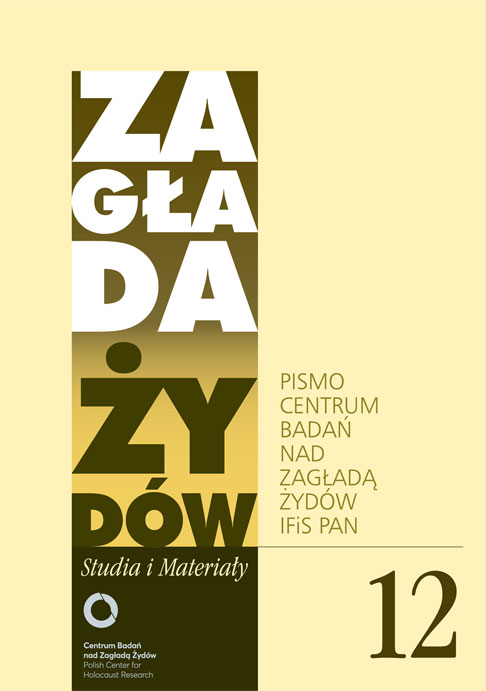Frankenstein w warszawskim getcie. Historia i legenda
Zagłada Żydów. Studia i Materiały, Nr 12 (2016), Strony: 187-208
Data zgłoszenia: 2020-10-19Data publikacji: 2016-11-30
 https://doi.org/10.32927/ZZSiM.414
https://doi.org/10.32927/ZZSiM.414
Abstrakt
The article deals with one exceptionally violent German perpetrator who was part of the occupation force in Warsaw during the Second World War. Inside the Ghetto he maltreated and killed a large number of women, children and men for his own personal pleasure. He did this to such an extensive degree that the population perceived him as monstrous being that was given the nickname „Frankenstein”. The article is mainly based on statements in juridical investigations, from the victim as well as from the perpetrator perspective, supplemented with some selected additional sources. Firstly the source corpus will be evaluated, to work out how these historical sources can be used to shed light on „Frankenstein”. This will be followed by an analysis of the actual identity of this perpetrator. It will be shown that he was, contrary to common belief, not necessarily the SS-Rottenführer Josef Blösche but more likely a member of the German Police Battalion 61. In the end the question will be also raised of how it was possible – despite all rules and regulations – that ghetto guards like him behaved like a marauding soldiery.
Słowa kluczowe
getto warszawskie , Zagłada , policja umundurowana , zbrodnie okupacyjne , warty w getcie , batalion policyjny , sprawca , przemoc , strach , terror , życie w getcie
Licencja
Prawa autorskie (c) 2016 Autor&"Zagłada Żydów. Studia i Materiały"

Utwór dostępny jest na licencji Creative Commons Uznanie autorstwa 4.0 Międzynarodowe.
https://creativecommons.org/licenses/by/4.0
Czasopismo publikowane jest w standardzie Diamond Open Access na licencji CC-BY-4.0 Deed - Uznanie autorstwa 4.0 Międzynarodowa - Creative Commons
Podobne artykuły
- Marian Turski, „Więcej nic nie powiem…” Rozmowa z Marianem Turskim – ocalałym z getta łódzkiego – przeprowadzona 28 sierpnia 2019 r. w przeddzień obchodów 75. rocznicy likwidacji getta łódzkiego , Zagłada Żydów. Studia i Materiały: Nr 16 (2020)
- Nawojka Cieślińska-Lobkowicz, Muzeum Pomnik Tragedii Drugiej Wojny Światowej , Zagłada Żydów. Studia i Materiały: Nr 13 (2017)
- Kathrin Stoll, Pogłoski w białostockim getcie. Przyczynek do historiografii Zagłady z perspektywy żydowskiej , Zagłada Żydów. Studia i Materiały: Nr 8 (2012)
- Luiza Nader, Pamiętanie afektywne. Moim przyjaciołom Żydom Władysława Strzemińskiego , Zagłada Żydów. Studia i Materiały: Nr 8 (2012)
- Nawojka Cieślińska-Lobkowicz, Magdalena Tarnowska, Artyści żydowscy w Warszawie 1939–1945; Ocalałe/Salvaged. Kolekcja malarstwa, rysunku i rzeźby ze zbiorów Żydowskiego Instytutu Historycznego , Zagłada Żydów. Studia i Materiały: Nr 12 (2016)
- Sławomir Buryła, Jerzy Jurandot, Miasto skazanych. 2 lata w warszawskim getcie, Stefania Grodzieńska, Dzieci getta , Zagłada Żydów. Studia i Materiały: Nr 12 (2016)
- Nawojka Cieślińska-Lobkowicz, Centrum Dokumentacji Nazizmu w Monachium i obywatelska pamięć Niemiec , Zagłada Żydów. Studia i Materiały: Nr 12 (2016)
- Katarzyna Woniak, Ujęcie Zagłady w niemieckich podręcznikach szkolnych , Zagłada Żydów. Studia i Materiały: Nr 11 (2015)
- Robert Szuchta, Czy zmiany programowe nauczania historii w polskiej szkole uwzględniają debaty historyczne? Refleksje na marginesie obrazu Zagłady w podręcznikach do nauczania historii , Zagłada Żydów. Studia i Materiały: Nr 11 (2015)
- Mikołaj Grynberg, O Auschwitz, Szwecji i depresji , Zagłada Żydów. Studia i Materiały: Nr 10 (2014)
<< < 23 24 25 26 27 28 29 30 31 32 33 34 35 36 37 38 39 40 41 42 43 44 45 46 47 48 49 50 51 52 53 54 55 56 57 > >>
Możesz również Rozpocznij zaawansowane wyszukiwanie podobieństw dla tego artykułu.
 English
English
 Język Polski
Język Polski




